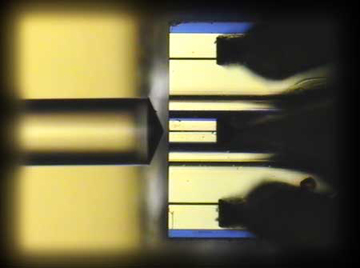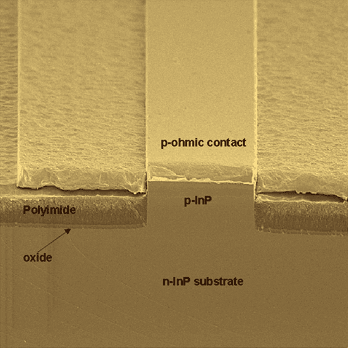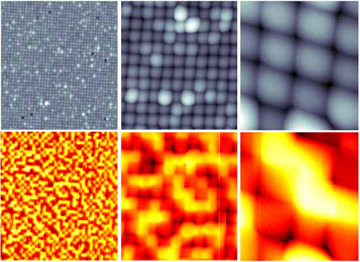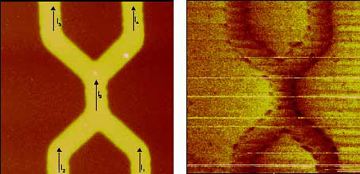
A high speed semiconductor laser coupled to a lensed optical fiber.
The Semiconductor Laser group (SLG), headed by Professor Rajeev Ram, is part of the Optics and Devices group of the Research Laboratory of Electronics. The SLG group makes extensive use of advanced semiconductor lasers to investigate a variety of topics in optical physics and devices.
Professor Ram describes the group’s research as taking place on three levels: physics, devices, and systems. In an ideal world, he says, research would progress from (a) advances in understanding of the physics of certain phenomena to (b) devices that take advantage of this understanding and then to © new or improved systems based on these devices. In fact, research often progresses in the opposite direction, with an attempt to improve the performance of a system inspiring the development of a new device which requires further investigation of underlying physical phenomena.
A case in point is the Bipolar Cascade Laser
The group was working with a fiberoptic communication system, trying to improve the overall signal-to-noise ratio of the system. The system converts electrical signal to optical signal and transmits it along fiberoptic cable with an ultrafast laser. To improve the signal-to-noise ratio of the transmission, one could increase the strength of the electrical signal going into the system, but the laser cannot handle more than a certain level of signal without creating distortion in the output transmission.
Instead, the group turned to the electrical-to-optical conversion process. By making this process more efficient, the optical signal strength could be increased without increasing the strength of the electrical signal going into the system. The result was the most efficient interband electrical-to-optical conversion device ever built, the bipolar cascade laser. This innovative device is built on a surprisingly simple premise: that by connecting the input electrical signal not to one laser but to two laser sections cascaded in series one could nearly double the output. The two laser sections were stacked on top of one another, allowing their output to be combined into an single, more powerful light stream.

Scanning electron micrograph of a high speed ridge waveguide laser.
The concept of the cascade laser, though simple, was a relatively new one, and there was no theory to describe how the paired lasers would interact and combine. The group developed its own theory which helped to optimize their device and proved helpful to other groups developing cascade lasers for different purposes. A collaboration resulted with Carlos Sitori at Thomson CSF in Paris who was developing a quantum cascade laser for pollution sensing systems. The Sitori group’s device operates at a wavelength of 10 microns, much longer than the 0.98 micron wavelength of the RLE group’s device, but the theory developed at RLE was sufficiently general to apply to this device.
Research on Magnetic Force Microscopy has followed a different path
Professor Ram and graduate student Mathew Abraham were investigating a new technique for imaging the flow of current through electrical wires. This technique, called magnetic force microscopy, had more than enough spatial resolution to image electron flow through electron wires as small as 2 microns in diameter, but to find just how high its resolution was, they needed a much smaller subject for imaging. The group contacted Professor Caroline Ross of MIT’s Magnetic Materials and Devices Group who had been looking for a way to image the magnetic fields in new material being developed for computer hard disks. This material, fabricated by Timothy A. Savas of Professor Henry I. Smith’s NanoStructures Laboratory, consists of tiny posts, only 57 nanometers wide, each of which can possess a magnetic charge. The magnetic posts were imaged successfully.

Topographical (above) and magnetic contrast (below) images of novel computer hard disk material. The topographical images show an array of magnetic posts at different magnifications, while the magnetic contrast images show their magnetic fields, essentially depicting the data stored on the disk.
Now that the magnetic fields of this advanced hard disk material could be imaged successfully, the group embarked on a collaboration with Professors Ross and Smith to learn more about the limits of hard drive density. Data storage density of current hard drives is roughly 4 Gb/in2. The materials being tested have storage densities around 60 Gb/in2. To achieve such density, the magnetically charged posts, each of which stores one bit, must be made very small and very close together, about 57 nm wide and 43 nm apart. At this scale, the magnetic fields of these posts can interact with each other, potentially creating instability in the stored data. This interaction was predicted, and its effect has been clearly observed using magnetic force microscopy. Current study focuses on estimating and better understanding these interactions and thereby learning more about the limits of hard disk density.
Meanwhile, progress continues on the original aim of magnetic force microscopy, imaging of currents flowing through electrical wires. The aim of this study is to investigate hydrodynamic behaviors of electric current. Electrons flowing at the edge of a wire flow more slowly than those in the center, just as water flowing close to the edge of a pipe flows slower than water at the center. The smaller the wire, the more significant the effect. The group hopes to use magnetic force microscopy to observe this effect and to help develop a model for understanding this fluid nature of electron flow. While the spatial resolution of this imaging technique is excellent, greater sensitivity is required to observe a current’s field than to observe the magnetic fields in hard disk material. The group hopes to increase sensitivity by a factor of one hundred from its current level, which would allow imaging on a quantum scale.

Left: a topographical scan of two 2 micron wide and 400 nanometer high metal wires that join together and then split apart. Right: a current contrast image of the junction. One can clearly see the sharper contrast over the central strip of wire indicating the larger current carried.
Laser Strobe
In another project, fast laser pulses are used as strobes to image very small, quick events.
This study aims at a better basic understanding of the magnetic property of electrons, known as spin. The spin of an electron, either “up” or “down,” denotes its magnetic orientation, corresponding with more everyday notions of the “north” and “south” poles of a magnet. By sending a beam of light through a cluster of electrons, one can force their spins to align. In most materials, this moment of perfect alignment will be extremely brief as random collisions with other particles change the electrons’ spins. In extremely pure semiconductors, however, there are few such collisions, and the electrons’ spins can remain aligned for much longer. The group is investigating how long the electrons can be made to remain in alignment, and what factors affect this. Understanding spin could open doors to new areas of electronics; for example, if spin can be made stable, transistors could use electrons’ spin to store information the way they now use charge.
The SLG is led by Professor Rajeev J. Ram and includes Research Scientist Charles H. Cox III; Postdoctoral Associate Holger Schmidt; graduate students Mathew C. Abraham, Harry Lee, Steve Patterson, Kevin Pipe, Farhan Rana, and Mehmet Fatih Yanik; and undergraduates Erwin Lau and Margaret Wang.
Related Links:
